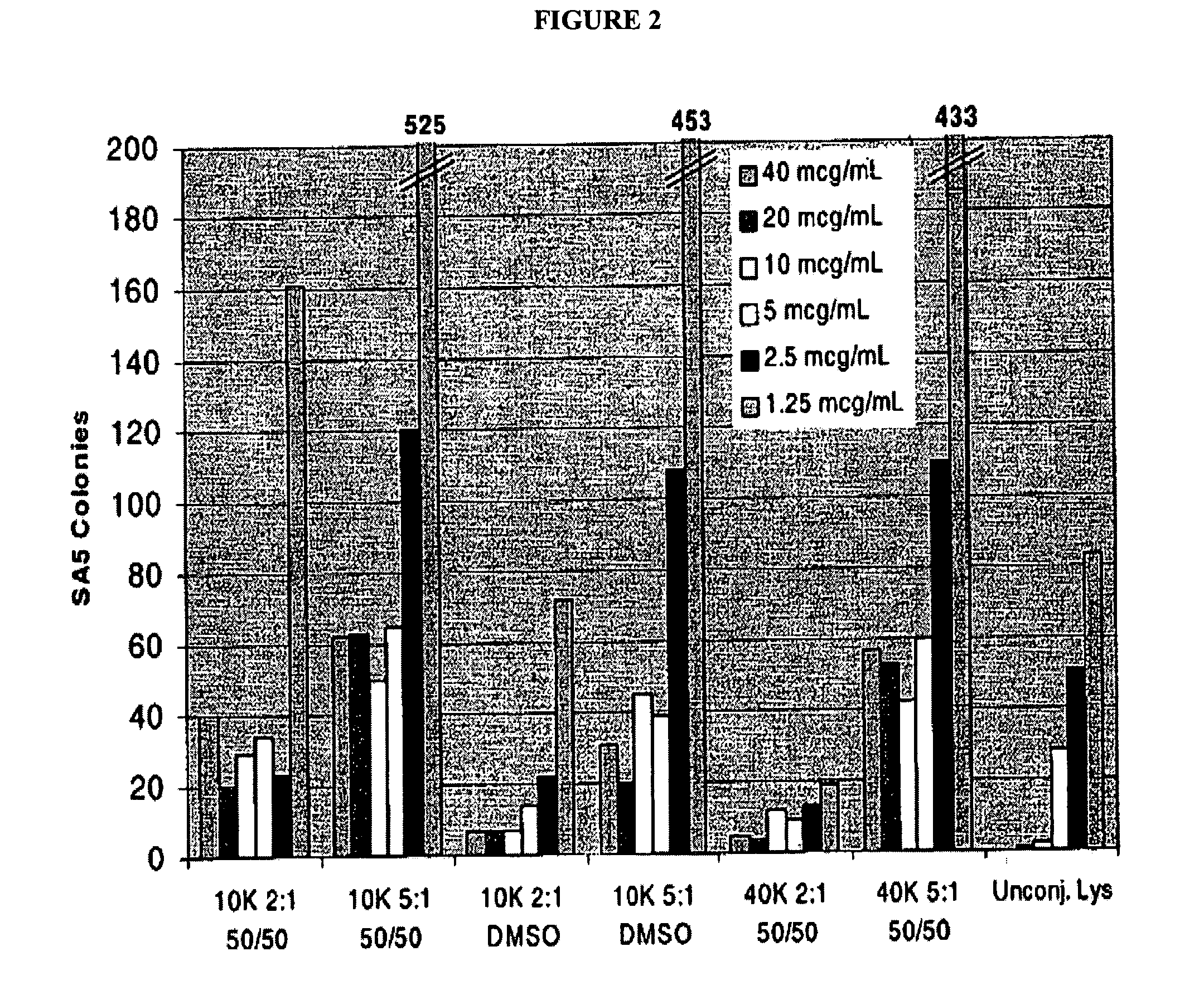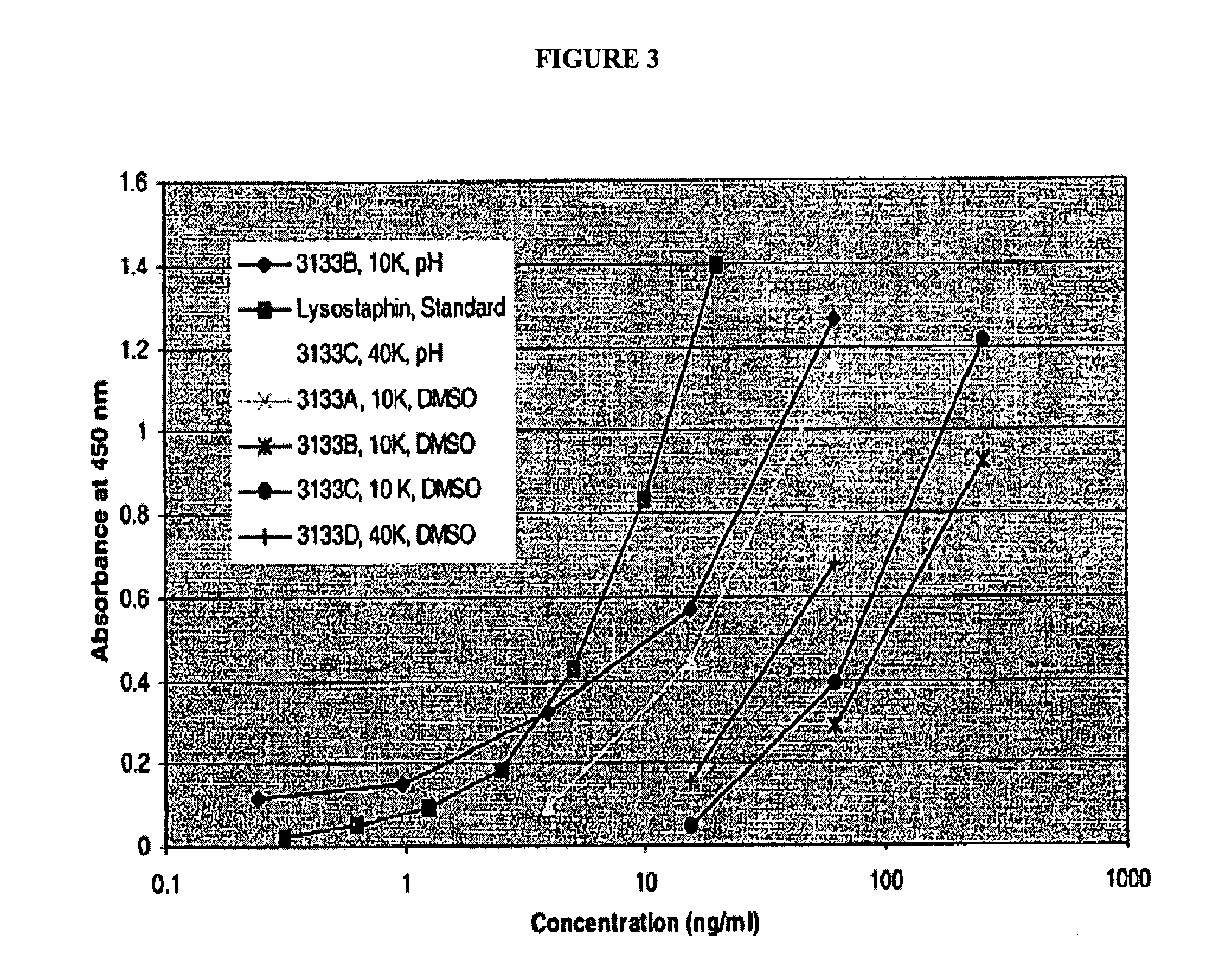Antimicrobial polymer conjugates
a technology of antimicrobial polymer and conjugate, which is applied in the field of conjugation of antimicrobial agents, can solve the problems of reducing its efficacy, causing significant morbidity and mortality, and high lethality, and achieves the effect of improving clinical properties and reducing immunogenicity
- Summary
- Abstract
- Description
- Claims
- Application Information
AI Technical Summary
Benefits of technology
Problems solved by technology
Method used
Image
Examples
example 1
Materials
[0086] As an example of an antimicrobial agent, lysostaphin was employed for these studies, which can be repeated with essentially any antimicrobial agent, as the term is defined by the present specification. Lysostaphin (AMBICIN L) was obtained from AMBI, Inc. (now Nutrition 21). The mPEG2-NHS esters, 10 and 40 kDa were purchased from Shearwater Corporation (Huntsville, Ala.) (now NEKTAR Therapeutics, AL). Sodium Borate, DMSO, bovine serum albumin, and extravidin-HRP were purchased from SIGMA Chemical Co. (St. Louis, Mo.). Glycine was purchased from EM Science (Gibbstown, N.J.). The NUPAGE Electrophoresis System and Colloidal Blue stain were purchased from INVITROGEN (Carlsbad, Calif.). SEPHACRYL S-100HR and HITRAP SP FF were purchased from AMERSHAM-PHARMACIA (Piscataway, N.J.). Tryptic Soy Broth, TSB, and Cation-Adjusted Mueller Hinton Broth, CAMHB, were purchased from BECTON DICKINSON (Sparks, Md.). TMB Microwell and 450 STOP Reagent were purchased from BIOFX (Owings Mi...
example 2
Characterization of PEGylated Lysostaphin
[0087] Lysostaphin PEGylation. Lysostaphin at 0.27, 1, or 5 mg / mL was dissolved in either 0.2M borate buffer (pH 8.5) or DMSO. The mPEG2-NHS esters were prepared in DMSO and added to the lysostaphin solution in molar excess at ratios of 40, 20, 10, 5 or 2.5:1. PEGylation was performed with three different buffer conditions, all at room temperature for 1, 2, or 3 hours: borate buffer (with <10% DMSO contributed by adding PEG), 50% borate / 50% DMSO, and 100% DMSO. All reactions were quenched by added glycine to 25 mM and vortexing.
[0088] PEG conjugation to lysostaphin was evaluated by SDS-PAGE with the NUPAGE Electrophoresis System. Non-reduced samples (300 ng) were run on a Novex 4-12% Bis-Tris gel at 115V and stained with colloidal blue. PEGylated lysostaphin was separated from unreacted lysostaphin by running the reaction mixture over a SEPHACRYL S-100HR column. Purified PEG-lysostaphin was concentrated and saved for activity assays.
[0089]...
example 3
Fractionation of 40 kD PEG Lysostaphin Conjugates
[0103] Fractionation of the various 40 kD PEG—lysostaphin conjugate species of Example 2 was performed by ion-exchange chromatography as a means to test enzyme activity as a function of PEG conjugation number. Fractions tended to be enriched in just one specific band. The mono-PEGylated form was purified to greater than 99% 1-mer, while the di-PEGylated form was purified to 93% 2-mer with the remainder contributed mostly by the 1-mer, as determined by size-exclusion chromatography HPLC.
[0104] Killing Assay for Activity: The ability of lysostaphin to kill S. aureus (SA) in saline was tested with varying concentrations of the enzyme. The bacteria were streaked onto blood agar plates after a 1-2 hour incubation with lysostaphin and surviving colonies were counted the next day. The data is reported in FIG. 5 as surviving colonies of SA so that the lower value on the graph, the more effective the killing of SA by lysostaphin. The 1-mer h...
PUM
| Property | Measurement | Unit |
|---|---|---|
| molecular weight | aaaaa | aaaaa |
| weight-average molecular weight | aaaaa | aaaaa |
| molecular weight | aaaaa | aaaaa |
Abstract
Description
Claims
Application Information
 Login to View More
Login to View More - R&D
- Intellectual Property
- Life Sciences
- Materials
- Tech Scout
- Unparalleled Data Quality
- Higher Quality Content
- 60% Fewer Hallucinations
Browse by: Latest US Patents, China's latest patents, Technical Efficacy Thesaurus, Application Domain, Technology Topic, Popular Technical Reports.
© 2025 PatSnap. All rights reserved.Legal|Privacy policy|Modern Slavery Act Transparency Statement|Sitemap|About US| Contact US: help@patsnap.com



